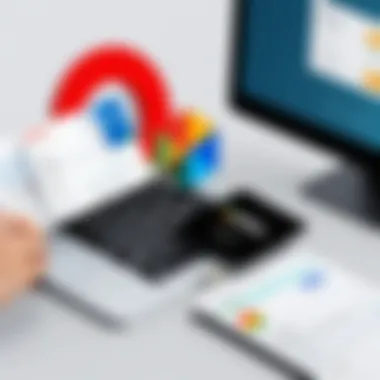Understanding Zoho Invoice ACH Payments: A Guide


Intro
In today's fast-paced financial landscape, businesses must adapt to efficient payment solutions. Automated Clearing House (ACH) payments have emerged as a powerful tool for streamlining transactions and enhancing cash flow management. This article highlights the integration of ACH payments with Zoho Invoice, an indispensable resource for professionals seeking a robust invoicing solution.
With the ability to automate payment processing, Zoho Invoice significantly reduces the manual workload and potential errors associated with invoicing. This guide will dissect the features, setup processes, benefits, and practical applications of ACH payments specifically within Zoho Invoice.
By understanding these elements, tech-savvy individuals and professionals in IT-related fields can optimize their financial management practices. The intention is for users to be better equipped to leverage the capabilities of Zoho Invoice to achieve greater efficiency in their business operations.
Software Overview
Key Features
Zoho Invoice offers an array of features tailored to facilitate financial management. Key highlights include:
- Customizable Invoices: Tailor designs to match your brand.
- Multi-Currency Support: Handle invoices in different currencies for global transactions.
- Recurring Billing: Automate billing for ongoing services.
- Expense Tracking: Log and categorize expenses efficiently.
- Integration with Payment Gateways: Connect to platforms like PayPal and Stripe for seamless payments.
- Reporting Tools: Generate reports for insights on spending and income.
Integrating ACH payments into Zoho Invoice enhances these features, enabling faster and more secure transactions directly from clients' bank accounts.
System Requirements
Utilizing Zoho Invoice, particularly with ACH payments, requires specific system capabilities. The base system requirements include:
- Operating System: Any modern web browser will suffice, as Zoho is a cloud-based platform.
- Internet Connection: Stable internet access is essential for real-time transaction processing.
- Device Compatibility: Desktop computers, laptops, and tablets can access Zoho Invoice effectively.
- User Accounts: An active Zoho account is necessary for access to features and reporting.
Ensuring your systems meet these requirements will allow for an optimal experience with ACH transactions in Zoho Invoice.
In-Depth Analysis
Performance and Usability
Zoho Invoice's integration of ACH payments boasts notable performance metrics. Transactions are processed quickly, often within a few business days, enhancing the cash flow cycle. The platform's user interface is intuitive, allowing users to set up and manage ACH payments with ease.
- Efficiency: Automating repetitive invoicing tasks reduces time spent on manual entries.
- Simplicity: Users can easily navigate through various features without steep learning curves.
- Reliability: Security measures, such as encryption and validation protocols, protect sensitive information, ensuring trust in the payment process.
Best Use Cases
Utilizing ACH payments within Zoho Invoice is particularly beneficial for businesses that often engage in recurring transactions. Examples of optimal use cases include:
- Subscription Services: Ideal for SaaS businesses where clients are billed on a regular basis.
- Freelancers: Professionals providing ongoing services can automate billing, thereby securing payment on time.
- E-commerce: Businesses selling products online can streamline payment processing, enhancing customer satisfaction.
"The integration of ACH payments with invoicing solutions like Zoho Invoice not only improves cash flow but also reinforces professional client relationships through reliable payment processing."
In summary, understanding the functionalities and efficiencies brought forth by Zoho Invoice with ACH payments is essential for effective financial management. The key features, usability, and associated business contexts create a compelling case for adopting this solution.
Prelude to Zoho Invoice ACH
In today's fast-paced business environment, the integration of technology in financial operations is essential for maintaining efficiency and accuracy. One significant aspect of this is the adoption of Automated Clearing House (ACH) payments within invoicing systems like Zoho Invoice. Understanding this integration is crucial as it not only simplifies transaction processes but also enhances financial management practices for companies of various sizes.
The relevance of Zoho Invoice in relation to ACH payments cannot be overstated. Zoho Invoice serves as a robust platform that allows businesses to streamline their invoicing processes while utilizing ACH as a means of payment. This blending of invoicing and banking technology enables faster transactions, reduces processing costs, and improves cash flow management. Furthermore, with regulatory scrutiny increasing across financial transactions, compliance becomes imperative. Therefore, understanding how to effectively utilize ACH with Zoho Invoice is of utmost importance for tech-savvy individuals and businesses looking to optimize their financial operations.
What is Zoho Invoice?
Zoho Invoice is a cloud-based invoicing software designed to aid businesses in creating, sending, and managing invoices effortlessly. With functionalities tailored to facilitate billing processes, users can customize invoices to their specifications, track payments, and generate insightful financial reports.
The key features of Zoho Invoice include:
- Professional Invoices: Create tailored invoices with company branding.
- Payment Reminders: Automated reminders for overdue payments help in improving cash flow.
- Expense Tracking: Users can monitor expenditures linked to specific projects or clients, aiding in overall financial management.
- Reporting Tools: Advanced reporting capabilities provide insights into business performance and help in strategic decision-making.


Overall, Zoho Invoice positions itself as a comprehensive tool for managing billing and invoicing needs, making it indispensable for small to medium-sized businesses.
Understanding ACH Payments
ACH payments represent a form of electronic transfer for payments within the United States. This system, regulated by the National Automated Clearing House Association (NACHA), facilitates the movement of funds between bank accounts efficiently. ACH payments have become increasingly popular due to their low cost, safety, and convenience.
Some essential aspects of ACH payments include:
- Direct Deposits: Many businesses use ACH for payroll, allowing employees to receive their wages directly into their bank accounts.
- Bill Payments: Consumers can set up ACH to automate recurring bill payments, reducing the likelihood of late fees.
- Cost-effective Transactions: Compared to credit card processing fees, ACH payments typically have lower transaction costs, appealing to many businesses.
In a world where financial transactions are shifting increasingly towards digital means, understanding ACH payments is vital for efficient transaction management.
The Intersection of Zoho Invoice and ACH
Combining Zoho Invoice with ACH payments creates a powerful tool for businesses. By enabling ACH transactions within Zoho Invoice, companies can benefit from seamless billing processes and improved cash flow. When clients receive an invoice, they can pay directly through ACH, reducing the time between invoicing and payment reception.
This intersection provides several advantages:
- Faster Payments: ACH payments are typically processed within two business days, significantly reducing traditional payment waiting time.
- Reduced Billing Errors: By automating the payment process, businesses can minimize errors often associated with manual data entry.
- Enhanced Tracking: Zoho Invoice’s reporting tools allow businesses to track payments against invoices efficiently, offering clarity on accounts receivable.
To summarize, the intersection of Zoho Invoice and ACH payments represents an innovative solution for businesses seeking efficiency and accuracy in their billing operations.
Setting Up Zoho Invoice for ACH
Setting up Zoho Invoice for ACH payments is vital for businesses looking to enhance their financial management. This step ensures a smooth flow of transactions and improves cash flow. By integrating ACH into Zoho Invoice, businesses can automate their receivables, making it easier to manage and collect payments. The benefits include reducing manual errors, speeding up payment processing, and providing a secure method for monetary transactions.
Creating a Zoho Invoice Account
To get started, you need to create a Zoho Invoice account. This process is straightforward. Visit the Zoho Invoice website and sign up with your email and relevant business details. After confirming your email, you can start tailoring your account to fit your business needs.
- Choose your currency and language
- Personalize your invoice templates
- Set billing preferences to match your payment cycle
Having a well-configured account lays the foundation for effective ACH integration.
Linking Your Bank Account
Once your account is set, the next step is linking your bank account. ACH transactions require a direct connection between your invoice system and your business's checking or savings account. In Zoho Invoice, navigate to the payment settings and select the option to add a bank account. Enter the requested details such as bank name, account number, and routing number carefully.
This is crucial for transferring payment data securely. Ensuring the information is correct minimizes discrepancies during processing. Take note that linking your bank account can take a few days for verification.
Configuring Payment Settings
After linking your bank account, you must configure the payment settings for ACH transactions. In Zoho Invoice, adjust your payment options by selecting ACH as a payment method. This allows clients to pay via ACH, streamlining their experience. Make sure to set up notification preferences for both you and your clients to stay informed of payment statuses.
Other factors to consider include:
- Setting up reminders for clients with outstanding invoices
- Customizing payment terms to encourage prompt payments
- Reviewing transaction fees related to ACH payments
By optimizing these settings, you enhance your invoicing process, making it user-friendly and efficient.
The integration of ACH payments within Zoho Invoice not only simplifies payment collection but also aligns well with modern financial practices, delivering a balance of efficiency and security.
Benefits of Using ACH with Zoho Invoice
Adopting ACH payments in Zoho Invoice offers several compelling advantages that can streamline business operations. ACH, or Automated Clearing House payments, facilitate electronic money transfers directly between bank accounts. This creates an efficient method of processing transactions, which is essential for businesses looking to optimize their financial workflows. Understanding these benefits is crucial for IT professionals, software developers, and students alike.
Cost Efficiency
One of the primary benefits of ACH payments is cost efficiency. Traditional payment methods often incur significant transaction fees, especially credit card payments, where processing fees can range from 2% to 3% or more. In contrast, ACH payments generally have lower fees, usually charged as a flat rate per transaction. This structure can lead to substantial savings for businesses, particularly those that handle a high volume of transactions.


Furthermore, ACH payments reduce the costs associated with check processing. The expenses linked to printing, mailing, and reconciling paper checks can add up quickly. By transitioning to electronic payments through Zoho Invoice, companies can streamline their expense management while enhancing overall cash flow management.
Speed and Convenience
Speed is another critical advantage of using ACH with Zoho Invoice. ACH transactions are typically processed quickly, often within one to two business days. This rapid completion enhances cash flow management. Businesses can expect faster access to funds while keeping their operations moving smoothly. This is particularly beneficial for service-based companies that depend on prompt payment to maintain their services and client relationships.
In terms of convenience, ACH payments simplify the invoicing process. By integrating ACH payments directly within the Zoho Invoice system, users can automate collection efforts. With recurring invoices set up for regular payments, businesses can ensure timely receipts without manual intervention. This automation not only saves time but also mitigates the risks of late payments and the manual errors often associated with them.
Enhanced Financial Tracking
Lastly, enhance financial tracking is a significant benefit of ACH payments within Zoho Invoice. With ACH integration, businesses can gain clearer insights into their financial activities. The automatic nature of these payments ensures that records are updated consistently, leading to greater visibility of cash flows.
Zoho Invoice allows users to generate detailed reports that analyze payment patterns. This information can guide decision-making and foster strategic planning. In addition, having a history of transactions linked directly to bank accounts simplifies audits and reconciliations, reducing the administrative burden upon finance teams.
"The true power of integrating ACH payments lies in its ability to transform not just payment processes, but the entire financial reporting landscape for businesses."
In summary, the integration of ACH payments in Zoho Invoice presents a practical approach for modern businesses. With cost efficiencies, improved speed, and enhanced financial tracking, companies can leverage these advantages to boost financial efficacy, eliminate unnecessary costs, and drive growth.
Using ACH for Invoicing
The landscape of invoicing and payment processing has been transformed with the introduction of Automated Clearing House (ACH) payments in systems like Zoho Invoice. Utilizing ACH for invoicing is becoming essential for businesses seeking efficiency and cost-effectiveness. This method is particularly suitable for B2B transactions where volume and recurring payments are high.
One of the primary benefits of using ACH for invoicing is the reduction in transaction fees. Traditional credit card payments can incur high fees, whereas ACH transfers generally have lower costs. Moreover, ACH payments are typically faster than checks, allowing for quicker reconciliation of accounts. This efficiency can enhance cash flow management for businesses involved in numerous transactions. Additionally, ACH offers improved tracking of payments, which is critical for accurate financial records and audits.
Using ACH also aligns with businesses that prioritize sustainability. The reduction of paper use and the shift to digital transactions can be a significant factor in improving a company's environmental footprint. Nevertheless, it is essential to recognize some considerations when implementing ACH as a payment option.
"Adopting ACH payments can streamline your financial operations and enhance overall efficiency for your business."
As companies transition to ACH payments, ensuring customer trust is crucial. Providing clear communication on how ACH works and the security measures in place can help mitigate concerns. Transparency about the process ensures that clients are more likely to adopt it.
Creating ACH Invoices
Creating ACH invoices within Zoho Invoice is a straightforward process that requires some essential steps. First, the business must set up its account to accept ACH payments. Once set up, you can create an invoice by navigating to the invoice creation section in your Zoho account. Here, you input the necessary details such as invoice number, description, amount, and due date.
One key advantage is that once an ACH invoice is created, you can add options for customers to choose their preferred payment method which includes ACH. This flexibility can increase the likelihood of faster payments. After completing the invoice, you send it digitally to your client.
Managing Recurring Payments
For businesses with clients requiring regular services, managing recurring payments through ACH is especially beneficial. Zoho Invoice enables users to set up automated recurring billing, which significantly reduces the manual effort involved in invoicing. You can define the frequency of invoicing, whether weekly, monthly, or annually.
To set up recurring payments, you simply select the appropriate client and specify the invoicing cycle. Ensure that you communicate the cycle to your client so that expectations are clear. This arrangement not only enhances cash flow predictability but also builds a stable financial relationship with clients.
Challenges and Considerations
When utilizing ACH payments via Zoho Invoice, it is crucial to acknowledge the challenges and considerations that can arise. Understanding these factors is essential for organizations seeking efficiency and reliability in their financial transactions. Challenges can include transaction errors, processing delays, and potential regulatory compliance issues. All of these can impact cash flow and overall business operations, making it vital to approach ACH implementations with diligence.
Common Issues with ACH Transactions
Common issues faced with ACH transactions can disrupt the payment process. Some of these include:
- Incorrect Account Information: Entering wrong routing or account numbers is often the culprit for failed transactions. When this happens, funds might not reach the intended recipient, leading to compliance with accounting practices and inconvenience for end-users.
- Insufficient Funds: In situations where the payer lacks sufficient funds, transactions can be returned. This results in additional fees and affects the timing of receiving payments.
- Processing Delays: ACH payments are generally efficient but may experience delays due to bank processing times. It is important for organizations to set expectations regarding the timeline of funds being available.
- Fraudulent Activity: The digital nature of ACH can expose accounts to unauthorized transactions. Maintaining robust security measures is consequently necessary to mitigate risks.
Companies using Zoho Invoice must ensure they have safeguards in place to address these common issues proactively. Proper training and system checks can enhance awareness of potential pitfalls and ensure smoother transactions.
Regulatory Compliance
Regulatory compliance is another significant aspect to consider when dealing with ACH payments in Zoho Invoice. The ACH network is governed by strict rules set forth by the National Automated Clearing House Association (NACHA). Businesses must ensure adherence to these regulations to avoid penalties and maintain operational integrity.
Key considerations include:


- Authorization for Transactions: Ensuring that all parties authorize transactions is essential. Without proper consent, organizations could face legal action and complications in the payment retrieval process.
- Data Security: Organizations must employ encrypted communication and secure data handling processes to protect sensitive information tied to ACH payments. Compliance with data privacy laws, such as GDPR, is necessary.
- Record Keeping: Chronicling all ACH transactions accurately is not just a best practice but often a regulatory requirement. It allows businesses to handle disputes effectively and comply with audits when they arise.
- Monitoring for Fraud: Maintaining vigilant monitoring against potential fraud is also key. This involves regularly reviewing account activity for suspicious behaviors.
Best Practices for ACH Transactions
Using ACH transactions effectively within Zoho Invoice requires a well-thought-out strategy. Best practices ensure smooth operations, reduce risks, and enhance overall financial management. The goal is to streamline processes while safeguarding sensitive data and optimizing collection efficiency.
Ensuring Security
Security is paramount when handling ACH transactions. Businesses must prioritize the protection of confidential banking information to prevent unauthorized access and fraud. Here are some crucial steps to enhance security:
- Use Strong Authentication: Implement multi-factor authentication for user accounts. This adds an extra layer of protection beyond just passwords.
- Limit Access: Only allow access to sensitive data to authorized personnel. Regularly review user permissions to keep them up to date.
- Regular Monitoring: Continuously monitor transactions to spot any unusual activity early. If anomalies occur, immediate action is required.
- Data Encryption: Use encryption to protect sensitive information during transmission. This makes it difficult for unauthorized entities to read data even if they intercept it.
- Update Security Protocols: Regularly assess and update your security measures to incorporate the latest technologies and practices.
By following these practices, businesses can significantly reduce the risk of data breaches and fraudulent activities.
Maintaining Accurate Records
Accurate record-keeping is integral to effective ACH transaction management. This practice helps in tracking payments, ensuring compliance, and simplifying audits. Here are some recommendations:
- Consistent Documentation: Always document every ACH transaction accurately. This should include transaction dates, amounts, and payer details.
- Automate Record Keeping: Utilize Zoho Invoice’s built-in features to automatically log transactions. This decreases the likelihood of human error and ensures consistency.
- Regular Reconciliation: Frequently reconcile bank statements with your internal records. This allows for early detection of discrepancies, minimizing potential issues.
- Backup Data Periodically: Regularly back up important financial records. This ensures that data is not lost due to technical failures or breaches.
Maintaining accurate financial records is not only important for business operations but also essential for regulatory compliance and reporting.
Improving Payment Collection Processes
Streamlining payment collection processes enhances cash flow and minimizes delays. Implementing effective methods will create a smoother experience for both the business and its clients. Consider these strategies:
- Set Clear Payment Terms: Clearly communicate payment terms on invoices. This helps clients understand their obligations and deadlines.
- Offer Payment Options: Provide various payment methods through Zoho Invoice, including ACH. This flexibility encourages timely payments from clients.
- Automate Reminder Systems: Leverage automation to send payment reminders before due dates. This proactive approach can significantly enhance collection rates.
- Regular Follow-Ups: If payments are overdue, initiate timely follow-up communications. This keeps the transaction top-of-mind for clients and fosters good relationships.
By improving payment collection processes, businesses can enhance cash flow efficiency and maintain healthy financial operations.
Future of ACH Payments in Zoho Invoice
The landscape of payment processing is evolving rapidly, necessitating businesses to adapt to these changes to maintain competitiveness. The future of ACH payments integrated with Zoho Invoice holds potential for significant advancements in how transactions are managed. As technology continually develops, the need for streamlined, cost-effective solutions becomes more pronounced. ACH payments, with their electronic and automated features, play a crucial role in this context. Understanding where they are headed can help businesses prepare for and leverage these advancements effectively.
Emerging Trends in Payment Processing
Several trends indicate how ACH payments will shape the future of payment processing. With the rise of digital wallets and e-commerce, businesses are increasingly looking towards ACH as a viable option for electronic payments.
- Increased Adoption of Direct Payments: Consumers expect flexibility in payment options, prompting businesses to adopt direct ACH payments more extensively.
- Enhanced Payment Security: As security risks grow, ACH payments are evolving with enhanced fraud prevention technologies. Businesses integrating these advancements will likely see reduced instances of fraud.
- Real-Time Payments: Modern payment systems are moving toward real-time processing. While traditional ACH may not offer instant payments, the introduction of same-day ACH is paving the way for quicker transactions.
These trends not only streamline operations but also improve customer satisfaction by offering quicker and more secure payment methods. Businesses using Zoho Invoice should stay informed on these developments to remain ahead.
Integration with Other Financial Tools
The integration of ACH payments with other financial tools is becoming increasingly significant for comprehensive financial management. Tools like accounting software, CRM systems, and ERP solutions are essential for businesses aiming for efficiency and accuracy in financial transactions.
- Automation of Repetitive Tasks: Integrating ACH with tools such as Xero or QuickBooks allows businesses to automate invoicing and payment collection, significantly reducing manual effort.
- Improved Financial Insights: Connecting Zoho Invoice with analytics tools can provide businesses with clearer insights into cash flow and payment patterns, helping refine financial strategies.
- Customizable APIs: Zoho provides APIs that make it easy to integrate with other tools. This flexibility enables businesses to create tailored solutions that accommodate specific needs.
Such integrations will not only enhance operational efficiency but also allow for deeper data analysis and a more strategic approach to financial management.
Closure
In this guide, we have examined the integration of ACH payments with Zoho Invoice, illustrating how this connection can significantly improve financial management for businesses of all sizes. The importance of this topic lies in its potential to transform transactional processes. ACH payments offer an efficient, cost-effective, and secure method for managing cash flow, which is critical in today's fast-paced business landscape.
Recap of Key Points
Throughout this article, we highlighted several essential elements:
- Effective Setup: We discussed the straightforward process of setting up Zoho Invoice for ACH payments, showcasing the need for a seamless user experience.
- Benefits Over Traditional Methods: ACH payments present numerous advantages such as lower fees, faster processing times, and improved cash flow management.
- Security Considerations: Maintaining a secure payment processing environment is paramount. The adoption of ACH does not diminish the need for robust security protocols.
- Future Trends: Emerging technologies in payment processing indicate a growing reliance on ACH methods within financial software solutions like Zoho Invoice.
Final Thoughts on Zoho Invoice and ACH
"The future of business transactions lies in seamless integrations of technology and finance."
To maintain a competitive edge, one must embrace these innovations and continuously explore the expanding capabilities of financial tools like Zoho Invoice.







